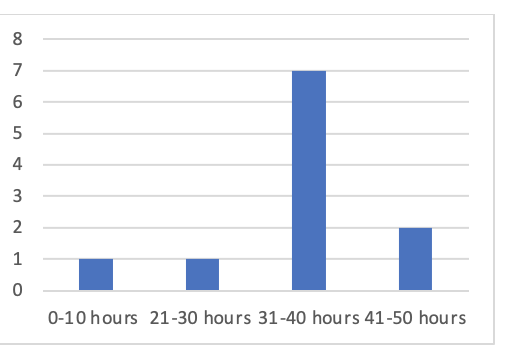Findings
For the quantitative findings section, the following variables were analyzed using descriptive statistics: Parent engagement (on a scale of 0-10) and the average hours worked in a week by the guardians. For this variable the mean was 7.73, The median score is 8, The mode is 10, and the standard deviation is 2.94. This can be seen in Table 1.
Table 1.
Parent Involvement
| Mean | Median | Mode | S.D. | |
| Level of Involvement | 7.73 | 8 | 10 | 2.94 |
The item that figure 1 is based on asks how many hours the guardian works a week on average. One respondent answered 0-10 hours. One respondent answered 21-30 hours. Seven respondents answered 31-40 hours. Two respondents answered 41-50 hours. This is seen in Figure 1.
Figure 1.
Average hours worked during the week

A bivariate analysis was run, and it was found that there was a dip in parental involvement if the parent worked 31-40 hours a week, but the parental involvement went back up at 41-50 hours. This can be seen in Table 3.
Table 3.
Parental involvement based on avg. hours worked in a week
| Hours worked in a week | Parent Involvement |
| 0-10 hours | 10 |
| 21-30 hours | 10 |
| 31-40 hours | 7.5 |
| 41-50 hours | 10 |
The key findings in this research are that most families that attend Head Start that turned in surveys were mostly involved and mostly worked 31-40 hours a week. The correlation between these variables shows that working 31-40 hours a week creates lower parent involvement. This may have skewed the research because of the low numbers in returned surveys that the average parental involvement of the most chosen option would have a lower average than those that are only selected once or three times in this case.
Finding the significance of these variables of involvement and hours worked by the parent using a Chi-Square. The Chi-Square results show that no parents recorded working 0-30 hours during the week and had low involvement. Nine parents recorded working0-30 hours during the week and high involvement. Thirty-six parents recorded 31+ hours worked in a week and having low involvement. Thirty-six parents recorded working 31+ hours in a week and having high involvement. This can be seen in table 4.
| Hours worked in a week | 0-30 Hours | 31+ Hours | Chi-Square |
| Low Involvement | 0 | 36 | 8.1* |
| High Involvement | 9 | 36 |
Table 4.
Chi-Square of Levels of involvement by hours worked by the parent
Note. p<.05*, p<.01**, p<.001***
The dependent variable for the Chi-Square is the level of involvement of parents in the leaf painting activity. Respondents were given a scale of 0-10 to answer from. For the Chi-Square, the responses have been recoded to “Low Involvement” (0-5) and “High Involvement” (6-10). The independent variable for the Chi-Square is on the hours worked by the parent in a week. The respondents were given the answer choices of 0-10, 11-20, 21-30, 31-40, 41-50, and 51+. This variable was recoded into “0-30 hours” and “31+ Hours.”
After running the Chi-Square, the Chi statistic is 8.1* and is significant. This means that there is a relationship between levels of involvement and the hours worked by the parents.
A T-Test was run to continually find the significance level of these variables in comparing the means. This can be seen in table 5.
Table 5.
T-Test for involvement by hours worked by parent
| Hours worked | Mean | T-Statistic |
| 0-30 hours | 10.000 | 11.582*** |
| 31-51+ | 7.857 |
Note. P<.05*, p<.01**, p<.001***
The dependent variable is the parent’s involvement in the leaf painting activity. The independent variable was the average hours worked during the week by the parent. The mean for 0-30 hours worked was 10.000, and the mean for 31-51+ hours was 7.857. This means, that parents who, on average, work fewer hours had more involvement in the painted leaf activity. The t-statistic is 11.582. This means, that if the data is generalized to the population level, is statistically significant to the .001 level giving it a three-star significance.
A Pearson Correlation was run following the Chi-Square and the T-Test to find the correlations between the two variables. The correlation that is being tested are two questions relating to the leaf painting activity. One question asks about the involvement of the parent during the activity and asks the parent to answer on a 0-10 scale. The second question asks if the parent would be willing to do the activity again with their child and asks them to answer on a scale of 0-10. The correlation shows that r = .32* meaning there was significance at the .5 level giving it a moderate positive correlation. This means that the higher the parent involvement, the higher the likelihood that the parent would participate in the activity again.
In the results of these tests, it is shown that the hours a parent works during the week influences the level of involvement that that parent has in their child’s schoolwork. These results from these tests are interesting because it could be thought that as a parent works more, this means there will be less free time for them to involve with their children. The results of these tests may actually show that the parents that work more during the week and hold stable jobs actually become more involved in their children’s learning because they see it as important to gain and retain employment.
